13 proactive strategies to reduce churn

.png)

.png)
Editor's note: This article was originally published in 2017. It has been updated with fresh content and insights in September 2022.
Commercial airlines run thorough maintenance checks on their planes between each flight to ensure there’s nothing wrong before they take off to their next destination. After all, it’s easier to identify and fix a broken plane when it’s at rest on the tarmac than when it’s hurtling toward the ground.
No one wants to board a shoddy 737 planning to fix it in midair. Yet so many companies build customer retention strategies that only aim to reduce churn after it becomes a problem. Reactive churn reduction strategies have their place, but proactive strategies are better adept at saving customers before they even experience turbulence in their user experience. Use these 13 proactive strategies to reduce churn and rescue customer revenue before you ever lose it.
Customer churn is the portion of customers who stop using a product or service within a given time period. This figure is most often represented as a percentage. If your product has 1,000 users at the start of the month but only 900 at the end of the month, your churn rate is 10%.
A certain amount of churn each period is inevitable. Users’ needs shift, their opinions change, and competitors consistently look for new ways to steal them away. Churn projections help companies plan for the revenue losses that accompany lost users. However, it’s not enough to simply know how many users are leaving. Companies looking to maximize their profits must consistently maintain active customer retention strategies to keep churn low to prevent their entire revenue stream from leaving their product.
A high churn rate equates to a loss in potential revenue. The fewer customers that leave, the more your user base grows—and the more money your product brings in.
Imagine signing one million subscribers in a quarter—only to lose a million and one. Companies can’t achieve growth if the number of people leaving a product constantly outweighs the number of people joining it.
This issue is especially problematic for SaaS companies, whose business models overwhelmingly favor subscription models. Potential revenue is spread out over time as opposed to being shelled out upfront, which means customers who bail early drag down profitability.
This makes reducing churn a priority for companies regardless of industry, size, or overarching goals. Even a marginal reduction in customer churn:
A low churn rate is also indicative of the total satisfaction of your user base, which in turn tells you how successful your product development and management efforts are. Most people won’t pay for products they don’t use or enjoy. If you’re losing a low number of users every period, it means you’re creating a product experience that meets or exceeds the expectations of the customers you serve.
Many teams make the mistake of waiting until the actual moment of attrition to deal with their churn problem instead of just being proactive. Retention efforts should begin at the moment of customer acquisition, not when customer satisfaction begins to wane. As Kristen LaFrance of Churn Buster argues, churn prevention should be part of a positive customer experience.
In his 2015 presentation at SaaSFest (the former name for ProfitWell’s annual Recur conference), Dan Wolchonok, head of product and analytics at Reforge, outlined 3 lifecycle stages of customer retention:
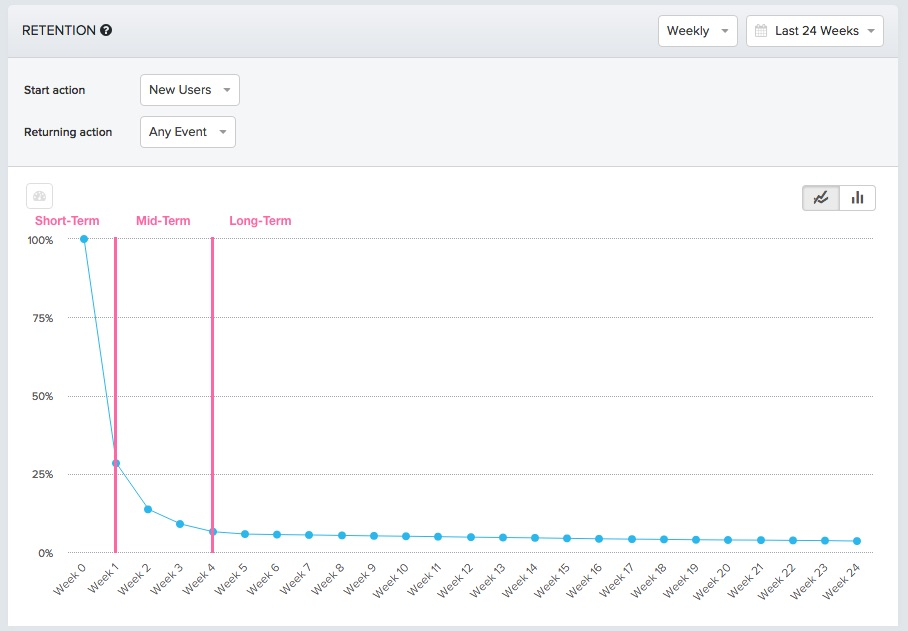
Wolchonok explained how improvements made early on tend to cascade through the second and third stages of the customer journey and affect retention across the board. The more you can engage users on their first visit or through their first week, the more likely they’ll stick around for the long term.
He also described how improvements made in the later stages tend to slow down the retention curve. These improvements keep the long-term retention rate from trending toward zero and ensure a sustainable subscriber base—which translates to sustainable growth for the company.
📖 Read more: Improve user and customer retention with these 9 quick wins
Take a look at how different churn reduction strategies apply to each of the 3 stages of churn.
The biggest drop in retention usually happens in the first week. Depending on your product, the time frame might be a little different—anywhere from the first visit, to the first day, week, or even the first month. You'll want to do a cohort analysis (grouped by acquisition cohort) to understand when users drop out of your own product and define the time frame that constitutes early-stage retention. But regardless of how you define it, improving early-stage retention is crucial to minimizing churn in the long run.
Ways to reduce early-stage churn:
Early-stage churn reduction requires shortening time to value and getting more customers to experience your product’s core value (or aha moment) as early as possible. This means you need to focus on improving your user onboarding experience.
Savvy product managers use any of several user onboarding best practices to reduce churn, but the following best practices will get you started:
SaaS solutions are a dime a dozen. If your users don’t find value in your product quickly and efficiently, there’s a very good chance that they’ll abandon your product in favor of another. But if you can shorten their time to value and help them find success early on, they’ll be far more likely to stick around. According to Wolchonok, a 15% improvement in user retention in the first week compounded into nearly twice the number of retained users after 10 weeks.
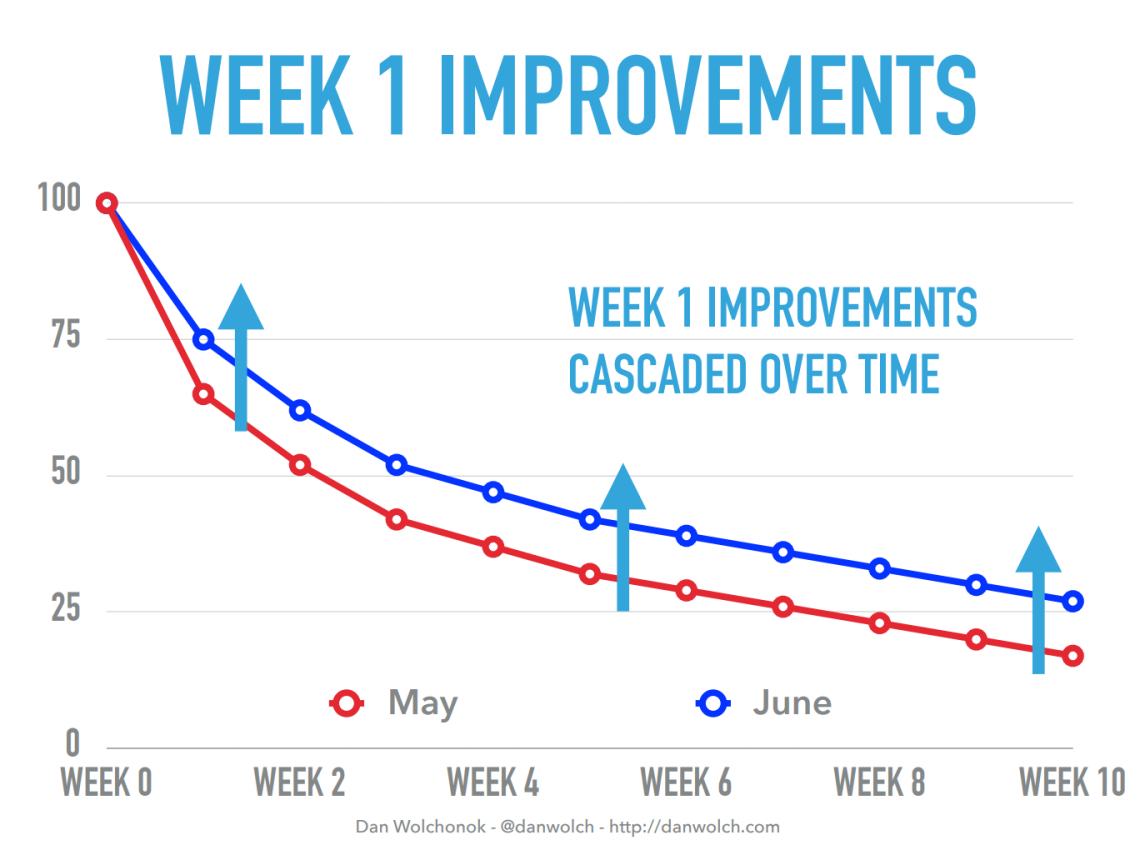
A personalized, friendly onboarding email builds trust with new subscribers and encourages them to get started with your product. They also have some of the highest open rates of any email. Your welcome email should remind users who you are and how your product can help them, as well as explain their next steps.
Here’s a great example of a welcome email from customer Analytics platform Clearbit:
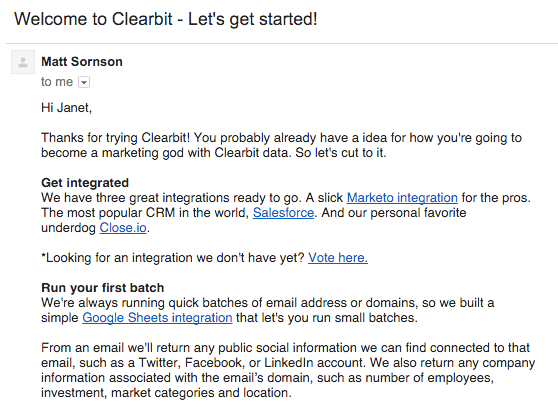
Be personal. Don’t send emails from a no-reply address. Instead, attribute your welcome email to the CEO, the head of customer success, or a similar role in the company. Ask customers to respond to your email directly:
Show them that you care about their experience and that you welcome customer feedback.
Video, written content, tooltips, product tours, and static images all help educate users, bringing them closer to your product’s activation moment. But finding the right types of content to use takes some experimentation. The team behind HubSpot’s Sidekick (now HubSpot Sales) performed over a half-dozen growth experiments before they were able to reduce their customer churn rate by 2%.
Iteration is key. Tools like Appcues make it fast and easy to experiment with different onboarding content and learn what works for your customers.
Once you’ve helped your customers experience the core value of your product for the first time, you need to turn your attention toward building customer loyalty and continued engagement.
Again: customer attrition is best dealt with proactively. Just because a user starts using your product doesn’t mean they’ll keep using it. Increasing mid-term retention means getting customers to create habits around your product so that they continue experiencing the core value it provides.
Ways to reduce mid-term churn include:
Users build habits around certain features as they become more familiar with your product. They also tend to ignore other areas or try to figure out each feature a couple of times before forgetting about them altogether. This limits how they use your product to a single, narrow use case.
It’s a phenomenon known as feature blindness. It may be fine for some users to ignore the bells and whistles, but it can spell disaster when users ignore core functionality. You want users to build habits around your product, but it can be difficult to break routines and encourage new behaviors in an existing product.
Try using tooltips or hotspots to point out features in context to combat feature blindness. Address the need when a user is most engaged instead of when users are focused on more familiar activities. This makes it much more likely they’ll pay attention to what you’re trying to show them. Here’s an example from GitHub:

Github uses a simple tooltip to introduce a new feature, allowing users to see how the feature works within the context of their normal use.
Open lines of communication with your customers are key to reducing churn. The more they use your product, the more important it becomes for you to understand why they love it and continue to use it.
Send a carefully timed survey to help you get to know your users and their needs. You’ll need to be careful with how you position your ask, especially in the early stages of the relationship. Many users simply aren’t willing to spend extra time completing a long survey before they’re fully invested in your product. Consider offering subscribers an incentive, like entering them into a giveaway to win a prize.
The survey itself should include mainly open-ended questions. Ask each customer:
Use the customer feedback you collect to improve your retention efforts.
📖 Read more: 6 outstanding examples of in-app user surveys, customer feedback forms, and NPS
User interest in your product starts to wear off after the excitement of the first few days. Still, everyone likes to feel like they’re the center of attention. Celebrate their progress within your app to remind users about the long-term value your product provides.
Trigger celebratory messages or emails on any kind of event, whether it’s using a feature for the first time, inviting a friend to join the app, or the 500th login. YouTube, for example, congratulates users when they pass 100 subscribers:
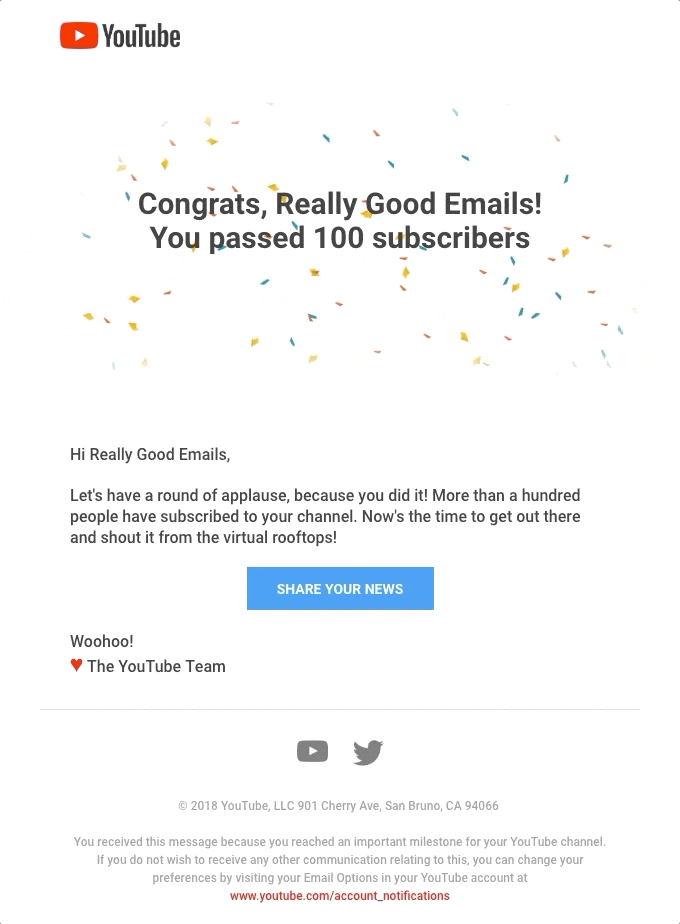
YouTube's email rewards users for engaging with the app, providing positive reinforcement and encouraging them to send more emails. Small gestures like this add a human touch and can be surprisingly effective at improving customer loyalty.
Brian Balfour, former VP of Growth at Hubspot, discovered while working on HubSpot's Sidekick product that creating new content on a consistent basis led to a noticeable decrease in customer churn:
“...we kind of found this [by] accident with content. We were auto-subscribing some of our users to the content that we are producing on our blog. And one day, I don’t know how we stumbled on this data, but we looked at this and we kind of broke this down and we realized that users who were receiving our blog content — it wasn’t even about the product, it was about a bunch of other things — actually retained significantly higher for us.”
Customer retention extends well beyond your product. Blogs, email newsletters, etc., provide extra value and let users engage outside your app, making them more likely to notice the ongoing value inside your app. Look for retention trends in your analytics data if you’re already creating content on a consistent basis. Are churn rates lower for subscribers who frequent your content? Leverage your top-performing content and make it part of the onboarding experience, distributing it to users via in-app messaging or drip emails.
The spark your product once ignited in a user eventually dims. Even after you’ve worked to make your product a part of users’ daily habits, you still need to continue demonstrating your core value to users as often as possible.
Ways to reduce long-term customer churn include:
Retention hooks are built-in features that give customers a reason to encourage other users to return to your product over time. Many social media sites have mastered this tactic. For example, LinkedIn encourages users to reach out to connections within their network, bringing those users back into the app and helping them rediscover its core value.
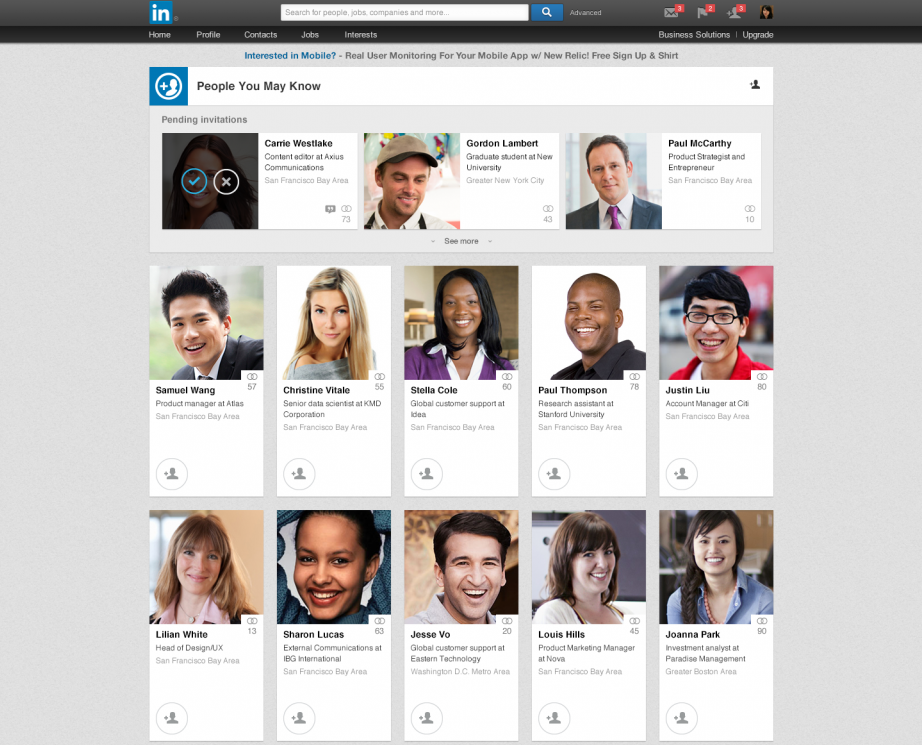
Inactive users are more likely to re-engage with the app since the reminders are coming from people they already know. And the best part? Retention hooks act like a flywheel, bringing inactive users back to your product without any extra effort on your part.
Sales reps are great at getting to know new customers, learning their needs, and working to understand their business problems. Unfortunately, that information often gets lost in the hand-off to the product team. Subscribers can easily become unhappy without the personal touch they experienced at the beginning of their journey.
The solution lies in better, more proactive customer service. Some companies are assigning a retention specialist to certain accounts to improve customer satisfaction well beyond the sales experience. The retention specialist works to keep customers happy, following up after each interaction and answering any questions they might have. Their work to maintain a close relationship and treat their customers more like partners reduces churn rate over time.
You can easily get by without a dedicated retention team if you’re constrained by resources. Have your PMs make a habit of reaching out to customers regularly. Don’t upsell them or grill them for customer feedback—just say “hi” and keep the lines of communication open. This approach creates a sense of ownership and personal investment, helping to improve customer loyalty and reduce attrition rates.
Don’t get caught off-guard by negative feedback. Track your Net Promoter Score (NPS) to keep your finger on your customers’ pulse. This helps you collect valuable customer feedback on why users love your product—and why they don’t.
The true value from NPS surveys doesn’t come from the individual scores, as Ondrej Sedlacek, co-founder of SatisMeter, explains:
“NPS is not about the score itself. It is about listening to your customers and helping them solve their problems. It is often overlooked to follow up immediately on every response. You can resolve unsatisfied customers' problems and effectively reduce their churn with NPS.”
Ask follow-up questions—especially to detractors. Use the feedback to guide your churn reduction efforts and home in on possible solutions. Take a look at how Norwegian healthcare portal PatientSky used Appcues to follow up with its NPS detractors by targeting the following flow to users who responded to the NPS survey with a score of 0 to 6:
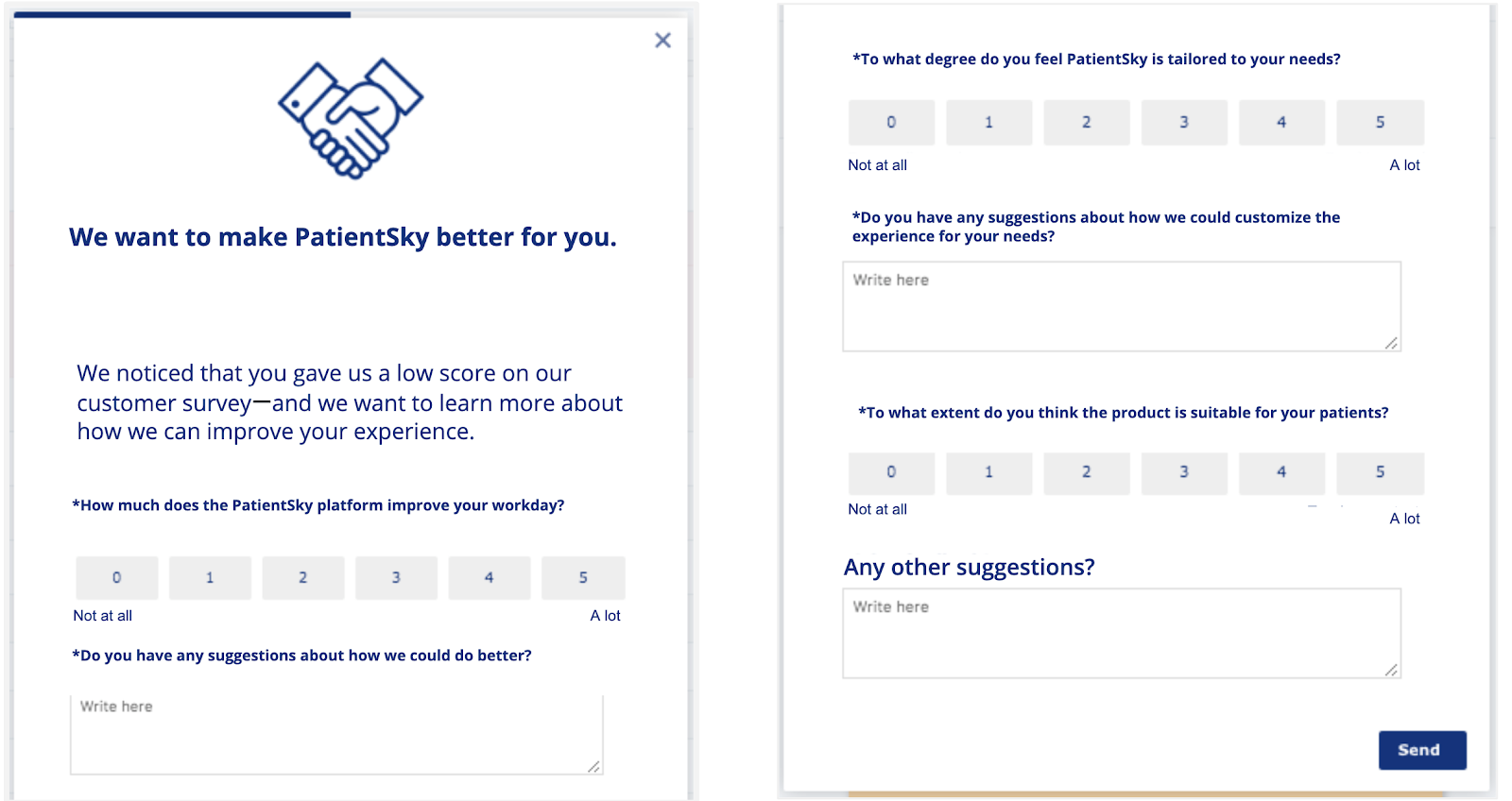
Monthly subscriptions likely make up the bulk of your SaaS company’s accounts, but nothing beats an annual contract for long-term retention.
Annual subscriptions give you more time in which to demonstrate value. A longer time frame makes it much more likely that your product will become a part of your customers’ routine. Data from ProfitWell shows that companies with a higher percentage of annual contracts experience lower churn rates. This is because customers on an annual contract only have one purchasing decision to make each year instead of 12.
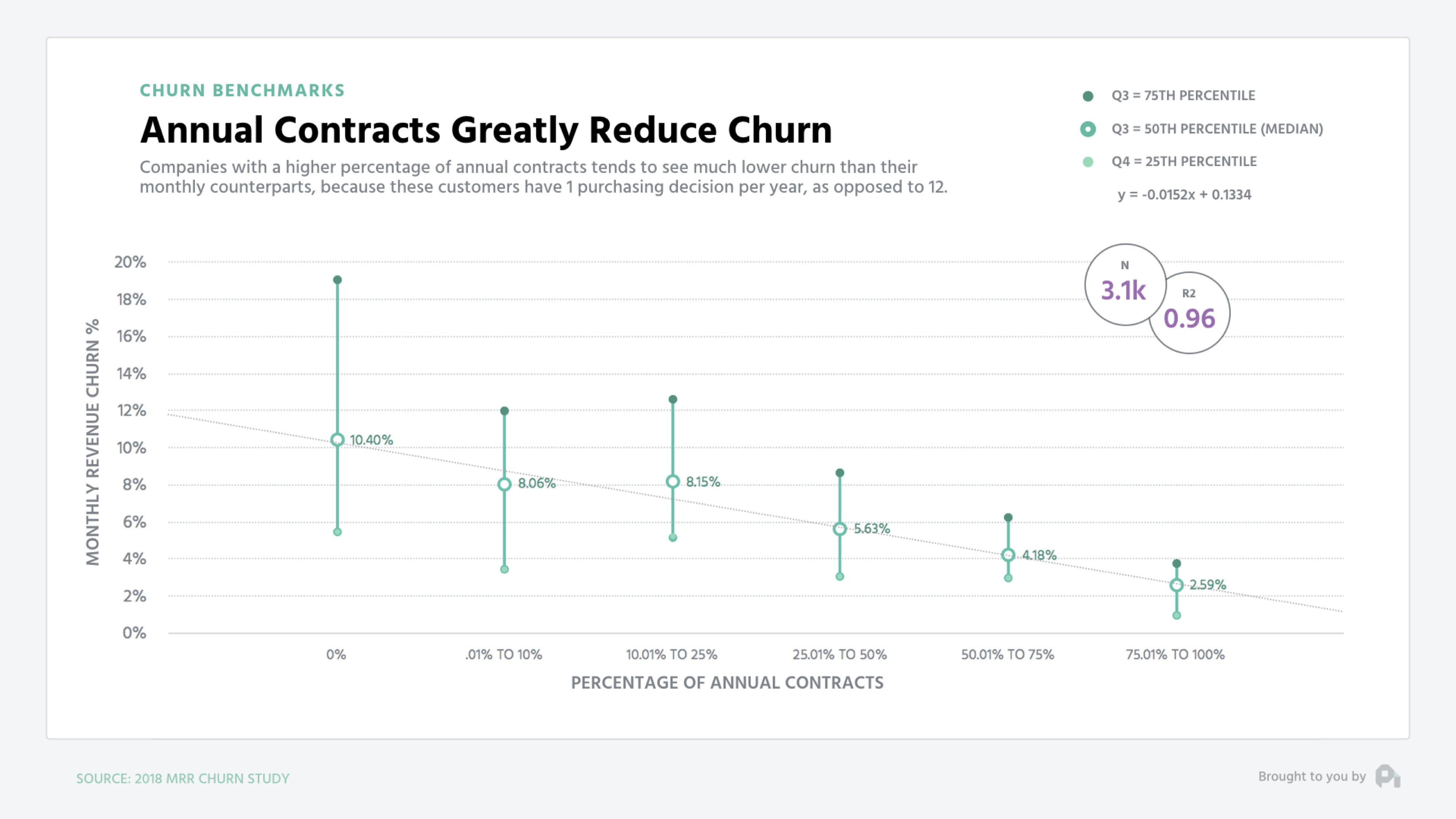
For most companies, it’s best to offer an upgrade to an annual plan after a subscriber has some experience using your product. An investment in an annual contract is a daunting decision for new customers who don’t yet understand how your product can benefit them. Make sure they get to experience the benefits you provide before you make the ask.
Email is often your best bet when it comes to re-engaging customers outside your app. A well-written retention email helps bring inactive users back from the dead, reminding them of the value you provide and reducing the chances they’ll abandon your app forever.
Check out this example from Blue Apron. It coaxes users back into the app without coming across as spammy or demanding:
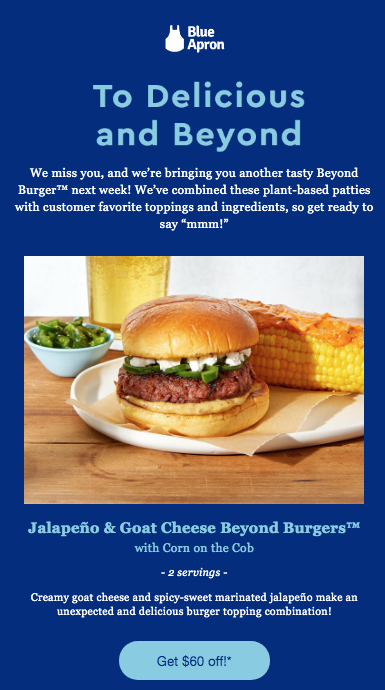
One of the best ways to resurrect inactive users is with a new feature update. Take this email example from Asana:
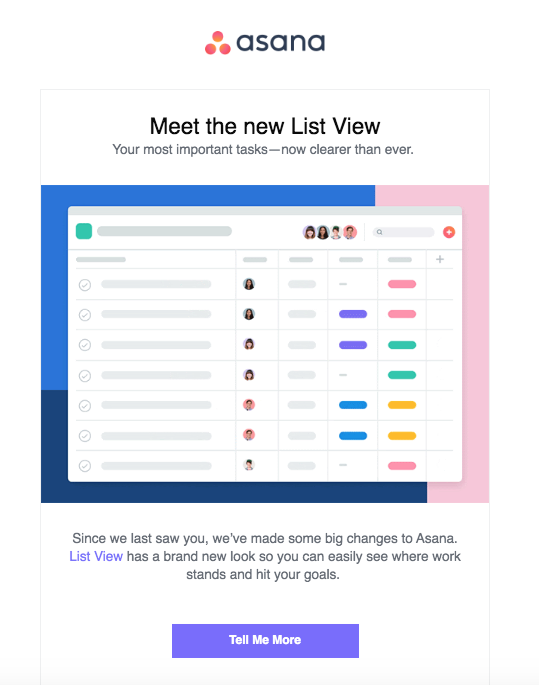
This email shows off a new feature to lapsed users. In the process, it highlights how the project management tool is constantly getting better. This gives disengaged users a reason to return.
No matter how proactive you are or how phenomenal your customer support is, some customer attrition is inevitable. That’s why it’s important to have an effective cancellation flow in place. A well-optimized cancellation flow actually helps prevent churn.
A great cancellation flow includes two essential elements:
Mailchimp uses these principles in its offboarding experience. Users are given the option to either pause their account and disable key functionality or delete their account and lose all historical data:
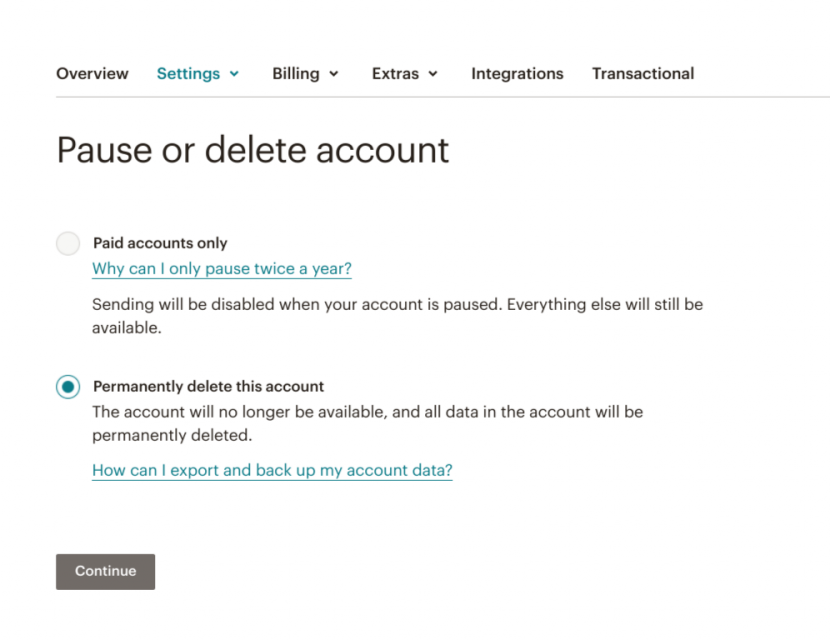
The first option essentially allows customers to keep all the value they’ve built inside the app for free—a no-brainer for most folks. Mailchimp can still re-engage these users and guide them back to a paid plan in the future. But Mailchimp offers a cheaper solution for those who do opt to delete their account. This path also acknowledges its customer’s decision to leave and politely asks for feedback.
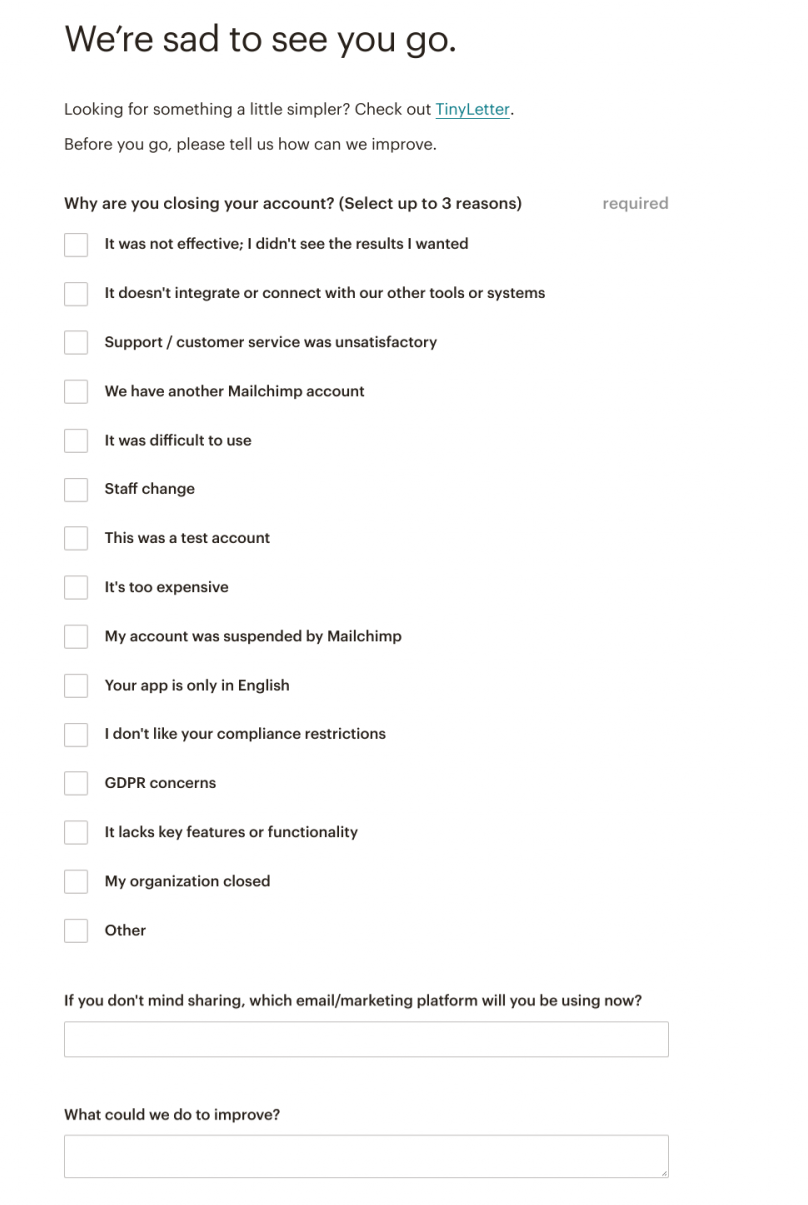

So many points of friction that lead users to churn are simply the results of poor communication. A user might desperately want to use a feature but can’t find it within your UI. Worse yet, you could lose a customer before they ever discover the true value of your product—the pivotal aha moment that shows them how your product solves their problems.
Appcues empowers you to tackle these churn risks head-on with the use of in-app messages. Modal windows, slideouts, tooltips, and more give direction and context at points of friction in the onboarding process and beyond. Well-timed in-app messages point users toward the features that convince users to stay and alleviate the frustrations that make them want to bail.
The best time to use Appcues’ in-app messaging was before your users became frustrated. The second-best time is now.
Use Appcues’ in-app messages to delight your users and tackle tricky churn issues
Customers will churn if a product doesn’t fulfill its promise of easing their specific pain points. They’ll also churn if a product takes too long to deliver on that promise. Many other factors also affect a product’s churn rate, including user experience (UX), customer engagement, and the allure of competitive offerings.
The formula for customer churn is remarkably simple, considering how important it is to the success of your business:
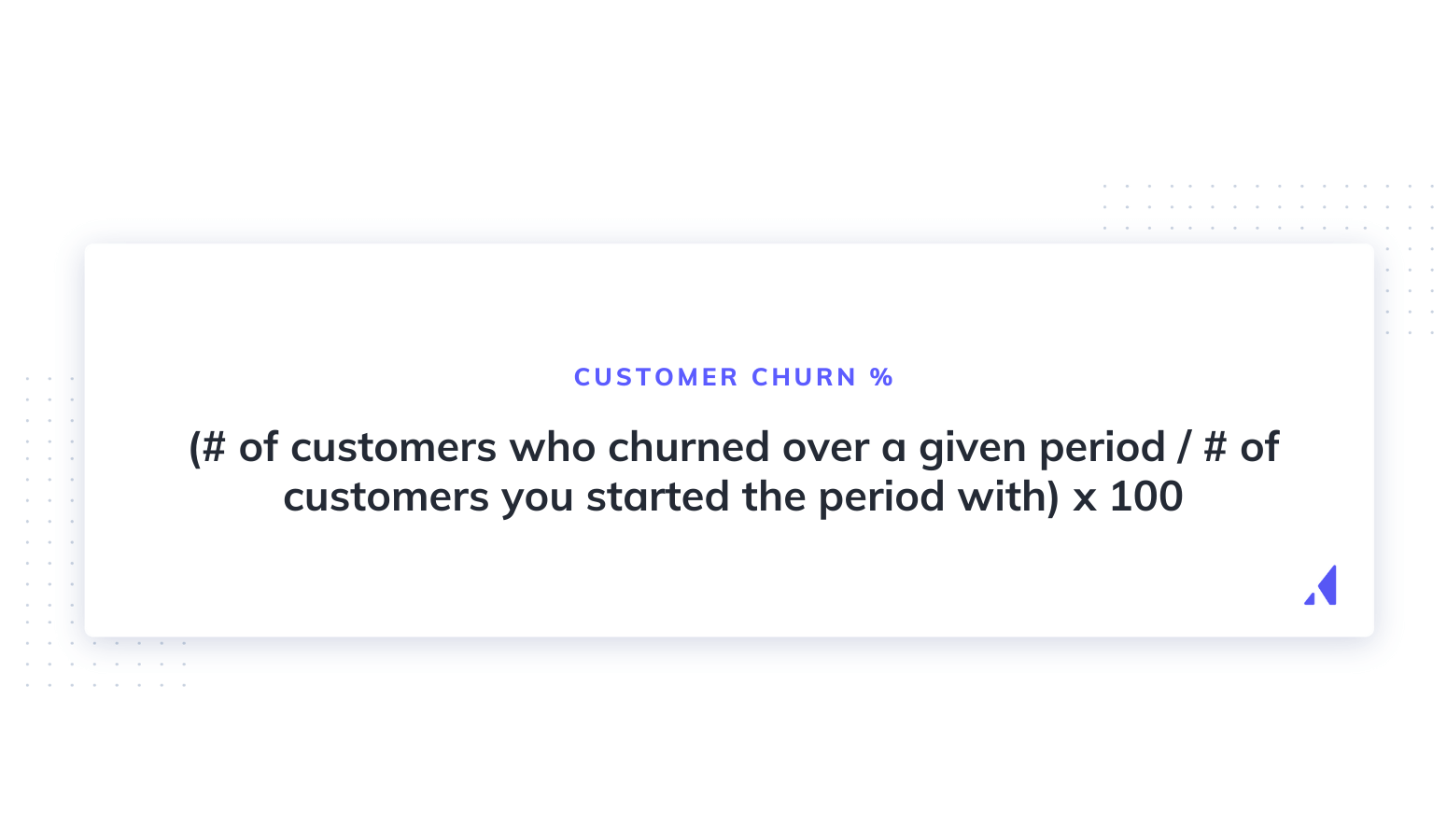
Common time periods used for this calculation include monthly, quarterly, and annually. Use the period that makes the most sense for your purposes. For instance, evaluate churn for last month to identify the immediate impact onboarding tweaks made to your churn rate.
The average SaaS user churn rate hovers around 5%. That said, it pays to improve upon this average. The closer you bring your churn rate to 0%, the more revenue your product will bring in—and the more money you’ll have to put toward further churn rate improvements.
“Turnover” and “churn” mean the same thing regarding a SaaS company’s customers. Both refer to the number of customers lost over a particular span of time. Both concepts are the inversion of the customer retention rate, which instead measures the customers a company keeps over a period of time.
Forward-thinking product managers use heat maps, churn prediction engines, A/B testing products, and more to improve their customer retention rates and reduce churn. Check out our review of 9 of the best customer retention tools on the market, including Appcues and our handy no-code in-app messaging solution.